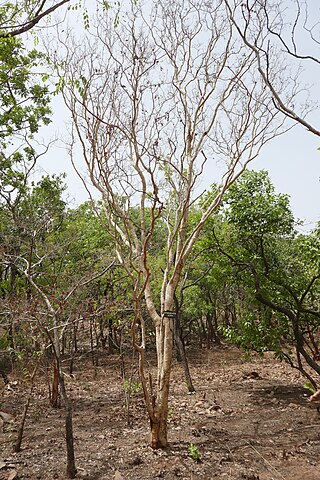
Phyllanthaceae is a family of flowering plants in the eudicot order Malpighiales. It is most closely related to the family Picrodendraceae.

Clutia is a plant genus of the family Peraceae. It is native to sub-Saharan Africa and to the Arabian Peninsula.

Leptopus, the maidenbushes, are a genus of plants in the family Phyllanthaceae native to southern Asia from the Caucasus east to China and Maluku. The plants are monoecious herbs and shrubs with simple, entire leaves and small, green flowers.

Bischofia is a genus of plants in the family Phyllanthaceae first described as a genus in 1827. It is native to southern China, the Indian Subcontinent, Queensland, New Guinea, and various islands of the Pacific. It is the only member of the tribe Bischofieae. They are dioecious, with male and female flowers on separate plants, but may rarely be monoecious.
Martretia is a genus of plants in the family Phyllanthaceae first described as a genus in 1907. It contains only one known species, Martretia quadricornis, native to western and central Africa from Sierra Leone to Zaire. It is dioecious, with male and female flowers on separate plants.

Hieronyma is a genus in the plant family Phyllanthaceae. It was first described as a genus in 1848. This family was formerly united with spurges, crotons, copperleaves, etc. (Euphorbiaceae), but have turned out to be well distinct. The genus is native to South America, Central America, southern Mexico, and the West Indies. It is dioecious, with male and female flowers on separate plants.
Leptonema is a genus of flowering plant belonging to the family Phyllanthaceae first described in 1824. The entire genus is endemic to Madagascar. It is dioecious, with male and female flowers on separate plants.
- Leptonema glabrum(Leandri) Leandri
- Leptonema venosum(Poir.) A.Juss.
Thecacoris is a genus of flowering plant belonging to the family Phyllanthaceae first described as a genus in 1821. It is native to tropical Africa and Madagascar. It is dioecious, with male and female flowers on separate plants, although it may rarely be monoecious.
Ashtonia is a genus of flowering plant belonging to the family Phyllanthaceae first described as a genus in 1968. It is native to the Malay Peninsula and Borneo. It is dioecious, with male and female flowers on separate plants.
- Ashtonia excelsa Airy Shaw - Borneo
- Ashtonia praeterita Airy Shaw - S Thailand, W Malaysia
Distichirhops is a genus of flowering plant belonging to the family Phyllanthaceae. The genus comprises 3 species, found in the secondary forests of New Guinea and Borneo. The taxon name comes from Greek, referring to its distichous leaf arrangement and shrubby habit.
Nothobaccaurea is a genus of flowering plant belonging to the family Phyllanthaceae, first described as a genus in 2000. It is native to various islands in the Pacific. The genus is named for its false resemblance with Baccaurea. Like Baccaurea, it is dioecious, with male and female flowers on separate plants.

Uapaca is a genus of plant, in the family Phyllanthaceae first described as a genus in 1858. It is the only genus comprised in the tribe Uapaceae. The genus is native to Africa and Madagascar. Uapaca is dioecious, with male and female flowers on separate plants.
Didymocistus is a genus of plants in the family Phyllanthaceae first described as a genus in 1940. It contains only one known species, Didymocistus chrysadenius, native to the Loreto region of northeastern Peru, the Amazonas Department of southeastern Colombia, and the State of Amazonas in northwestern Brazil. It is dioecious, with male and female flowers on separate plants.

Hymenocardia is a genus of trees in the family Phyllanthaceae first described as a genus in 1836. Most of the species are native to Africa, with one in Southeast Asia.
Chorisandrachne is a genus of plants in the family Phyllanthaceae first described as a genus in 1969. It contains only one known species, Chorisandrachne diplosperma, native to southern Thailand.
Keayodendron is a genus of plants in the family Phyllanthaceae first described as a genus in 1959. It contains only one known species, Keayodendron bridelioides, native to tropical western and Central Africa. It is dioecious, with male and female flowers on separate plants.

Meineckia is a genus of flowering plants in the family Phyllanthaceae first described as a genus in 1858.
Gonatogyne is a genus of plants in the family Phyllanthaceae first described as a genus in 1873. It contains only one known species, Gonatogyne brasiliensis, endemic to southeastern Brazil. It is dioecious, with male and female flowers on separate plants.
Heywoodia is a genus of plants in the Phyllanthaceae first described as a genus in 1907. It contains only one known species, Heywoodia lucens, native to eastern, southeastern, and southern Africa.
Pseudophyllanthus is a monotypic genus of flowering plants in the family Phyllanthaceae. It is one of the eight genera in the tribe Poranthereae. Its closest relative is Poranthera. Its sole species is Pseudophyllanthus ovalis.








